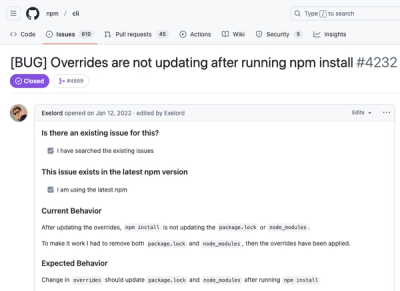What is stealthy-require?
The stealthy-require npm package allows you to require a module in a way that avoids caching, enabling you to load the module fresh every time. This can be useful for testing, mocking, or when you need to ensure that the module's state is reset.
What are stealthy-require's main functionalities?
Require a module without caching
This feature allows you to require a module without it being cached. This is useful when you need to ensure that the module is loaded fresh every time, such as in testing scenarios.
const stealthyRequire = require('stealthy-require');
// Load the module without caching
const myModule = stealthyRequire(require.cache, function () {
return require('my-module');
});
Require a module with specific dependencies
This feature allows you to require a module along with specific dependencies. This can be useful when you need to control the environment in which the module is loaded.
const stealthyRequire = require('stealthy-require');
// Load the module with specific dependencies
const myModule = stealthyRequire(require.cache, function () {
return require('my-module');
}, function () {
require('dependency1');
require('dependency2');
});
Other packages similar to stealthy-require
proxyquire
Proxyquire is a powerful tool for overriding dependencies during testing. Unlike stealthy-require, which focuses on avoiding cache, proxyquire allows you to mock dependencies, making it more suitable for complex testing scenarios.
mock-require
Mock-require is another package that allows you to mock modules during testing. It provides a simpler API compared to proxyquire and is focused on replacing modules with mocks, similar to stealthy-require but with a different approach.
clear-require
Clear-require is a package that allows you to clear a module from the require cache. While stealthy-require avoids caching altogether, clear-require gives you control over when to clear the cache, providing more flexibility.
Stealthy-Require



This is probably the closest you can currently get to require something in node.js with completely bypassing the require cache.
stealthy-require works like this:
- It clears the require cache.
- It calls a callback in which you require your module(s) without the cache kicking in.
- It clears the cache again and restores its old state.
The restrictions are:
- Native modules cannot be required twice. Thus this module bypasses the require cache only for non-native (e.g. JS) modules.
- The require cache is only bypassed for all operations that happen synchronously when a module is required. If a module lazy loads another module at a later time that require call will not bypass the cache anymore.
This means you should have a close look at all internal require calls before you decide to use this library.
Installation

This is a module for node.js and is installed via npm:
npm install stealthy-require --save
Usage
Let's say you want to bypass the require cache for this require call:
var request = require('request');
With stealthy-require you can do that like this:
var stealthyRequire = require('stealthy-require');
var requestFresh = stealthyRequire(require.cache, function () {
return require('request');
});
The require cache is bypassed for the module you require (i.e. request) as well as all modules the module requires (i.e. http and many more).
Sometimes the require cache shall not be bypassed for specific modules. E.g. request is required but tough-cookie – on which request depends on – shall be required using the regular cache. For that you can pass two extra arguments to stealthyRequire(...):
- A callback that requires the modules that shall be required without bypassing the cache
- The
module variable
var stealthyRequire = require('stealthy-require');
var requestFresh = stealthyRequire(require.cache, function () {
return require('request');
},
function () {
require('tough-cookie');
}, module);
Usage with Module Bundlers
- Webpack works out-of-the-box like described in the Usage section above.
- Browserify does not expose
require.cache. However, as of browserify@13.0.1 the cache is passed as the 6th argument to CommonJS modules. Thus you can pass this argument instead:
var requestFresh = stealthyRequire(arguments[5], function () {
return require('request');
});
Preventing a Memory Leak When Repeatedly Requiring Fresh Module Instances in Node.js
If you are using stealthy-require in node.js and repeatedly require fresh module instances the module.children array will hold all module instances which prevents unneeded instances to be garbage collected.
Assume your code calls doSomething() repeatedly.
var stealthyRequire = require('stealthy-require');
function doSomething() {
var freshInstance = stealthyRequire(require.cache, function () {
return require('some-module');
});
return freshInstance.calc();
}
After doSomething() returns freshInstance is not used anymore but won’t be garbage collected because module.children still holds a reference. The solution is to truncate module.children accordingly:
var stealthyRequire = require('stealthy-require');
function doSomething() {
var initialChildren = module.children.slice();
var freshInstance = stealthyRequire(require.cache, function () {
return require('some-module');
});
module.children = initialChildren;
return freshInstance.calc();
}
The slice operation removes all new module.children entries created during the stealthyRequire(...) call and thus freshInstance gets garbage collected after doSomething() returns.
Technical Walkthrough
var stealthyRequire = require('stealthy-require');
var request1 = require('request');
var requestFresh = stealthyRequire(require.cache, function () {
return require('request');
});
var request2 = require('request');
request1 === request2
request1 === requestFresh
Contributing
To set up your development environment for stealthy-require:
- Clone this repo to your desktop,
- in the shell
cd to the main folder,
- hit
npm install,
- hit
npm install gulp -g if you haven't installed gulp globally yet, and
- run
gulp dev. (Or run node ./node_modules/.bin/gulp dev if you don't want to install gulp globally.)
gulp dev watches all source files and if you save some changes it will lint the code and execute all tests. The test coverage report can be viewed from ./coverage/lcov-report/index.html.
If you want to debug a test you should use gulp test-without-coverage to run all tests without obscuring the code by the test coverage instrumentation.
Change History
- v1.1.1 (2017-05-08)
- Fix that stops
undefined entries from appearing in require.cache (Thanks to @jasperjn from reporting this in issue #4)
- v1.1.0 (2017-04-25)
- Added ability to disable bypassing the cache for certain modules (Thanks to @novemberborn for suggesting this in issue #3)
- Added section in README about a potential memory leak (Thanks to @Flarna and @novemberborn for bringing that up in issue #2)
- Performance optimizations (Thanks to @jcready for pull request #1)
- v1.0.0 (2016-07-18)
- Breaking Change: API completely changed. Please read the Usage section again.
- Redesigned library to support module bundlers like Webpack and Browserify
- v0.1.0 (2016-05-26)
License (ISC)
In case you never heard about the ISC license it is functionally equivalent to the MIT license.
See the LICENSE file for details.







